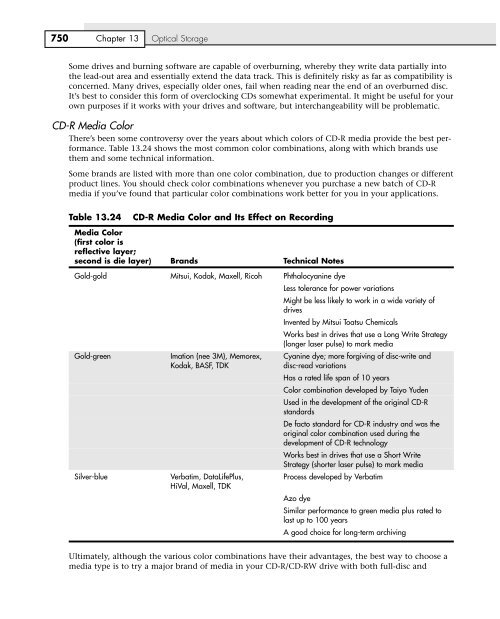Create successful ePaper yourself
Turn your PDF publications into a flip-book with our unique Google optimized e-Paper software.
750 Chapter <strong>13</strong> Optical Storage<br />
Some drives and burning software are capable of overburning, whereby they write data partially into<br />
the lead-out area and essentially extend the data track. This is definitely risky as far as compatibility is<br />
concerned. Many drives, especially older ones, fail when reading near the end of an overburned disc.<br />
It’s best to consider this form of overclocking CDs somewhat experimental. It might be useful for your<br />
own purposes if it works with your drives and software, but interchangeability will be problematic.<br />
CD-R Media Color<br />
There’s been some controversy over the years about which colors of CD-R media provide the best performance.<br />
Table <strong>13</strong>.24 shows the most common color combinations, along with which brands use<br />
them and some technical information.<br />
Some brands are listed with more than one color combination, due to production changes or different<br />
product lines. You should check color combinations whenever you purchase a new batch of CD-R<br />
media if you’ve found that particular color combinations work better for you in your applications.<br />
Table <strong>13</strong>.24 CD-R Media Color and Its Effect on Recording<br />
Media Color<br />
(first color is<br />
reflective layer;<br />
second is die layer) Brands Technical Notes<br />
Gold-gold Mitsui, Kodak, Maxell, Ricoh Phthalocyanine dye<br />
Less tolerance for power variations<br />
Might be less likely to work in a wide variety of<br />
drives<br />
Invented by Mitsui Toatsu Chemicals<br />
Works best in drives that use a Long Write Strategy<br />
(longer laser pulse) to mark media<br />
Gold-green Imation (nee 3M), Memorex, Cyanine dye; more forgiving of disc-write and<br />
Kodak, BASF, TDK disc-read variations<br />
Has a rated life span of 10 years<br />
Color combination developed by Taiyo Yuden<br />
Used in the development of the original CD-R<br />
standards<br />
De facto standard for CD-R industry and was the<br />
original color combination used during the<br />
development of CD-R technology<br />
Works best in drives that use a Short Write<br />
Strategy (shorter laser pulse) to mark media<br />
Silver-blue Verbatim, DataLifePlus,<br />
HiVal, Maxell, TDK<br />
Process developed by Verbatim<br />
Azo dye<br />
Similar performance to green media plus rated to<br />
last up to 100 years<br />
A good choice for long-term archiving<br />
Ultimately, although the various color combinations have their advantages, the best way to choose a<br />
media type is to try a major brand of media in your CD-R/CD-RW drive with both full-disc and
















